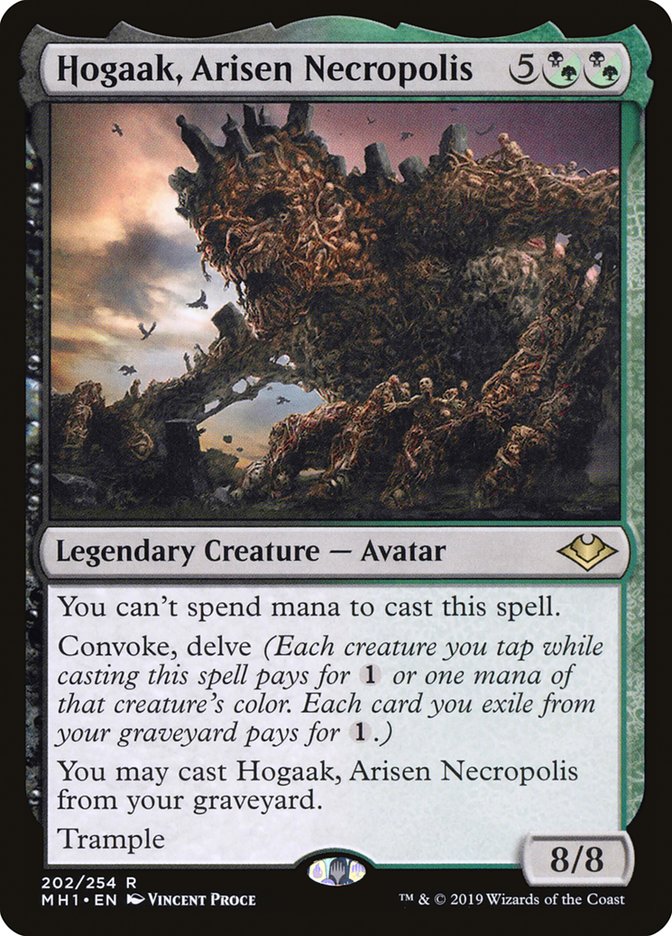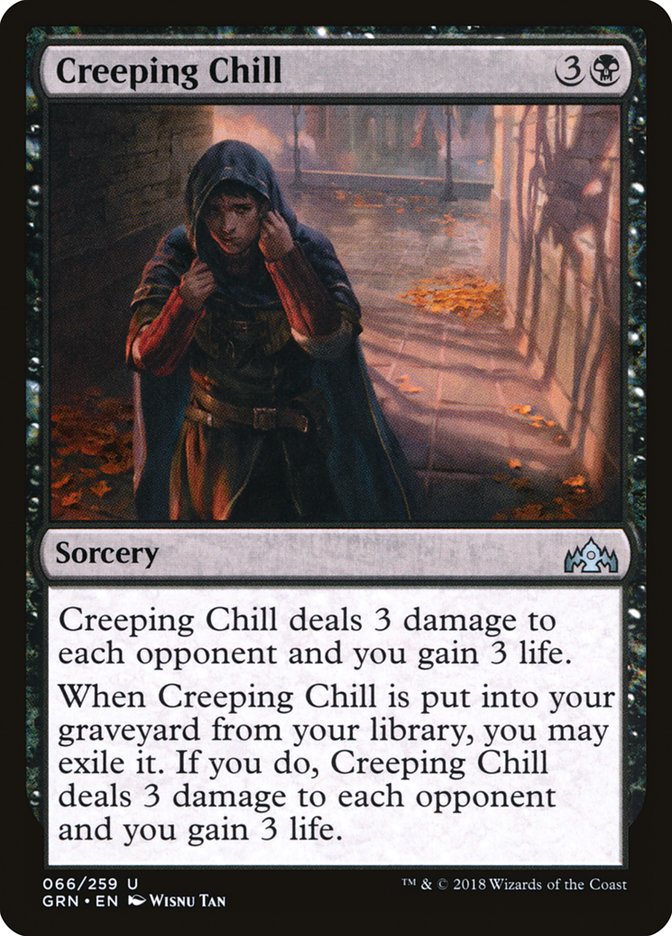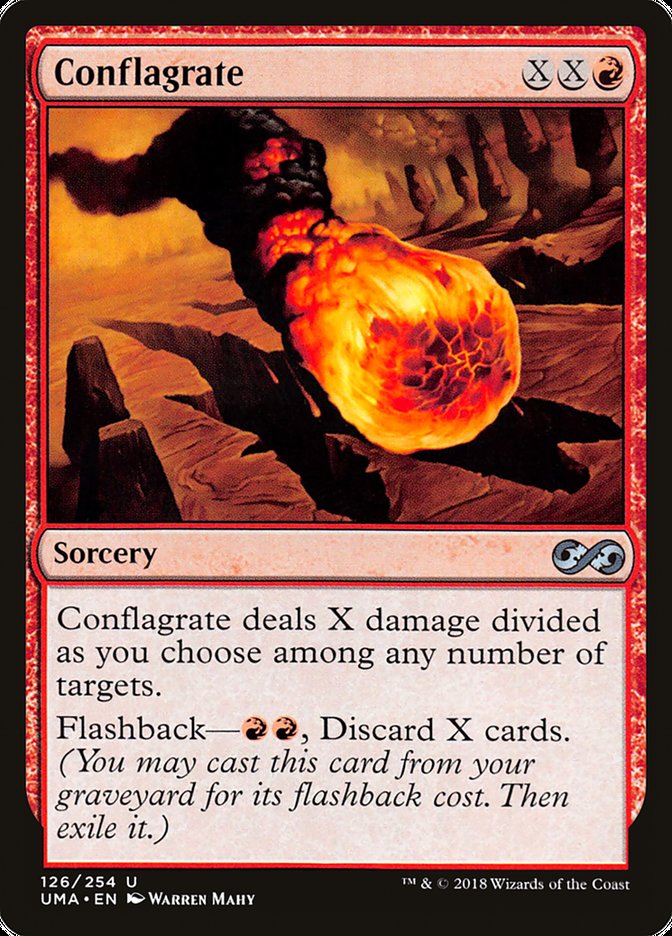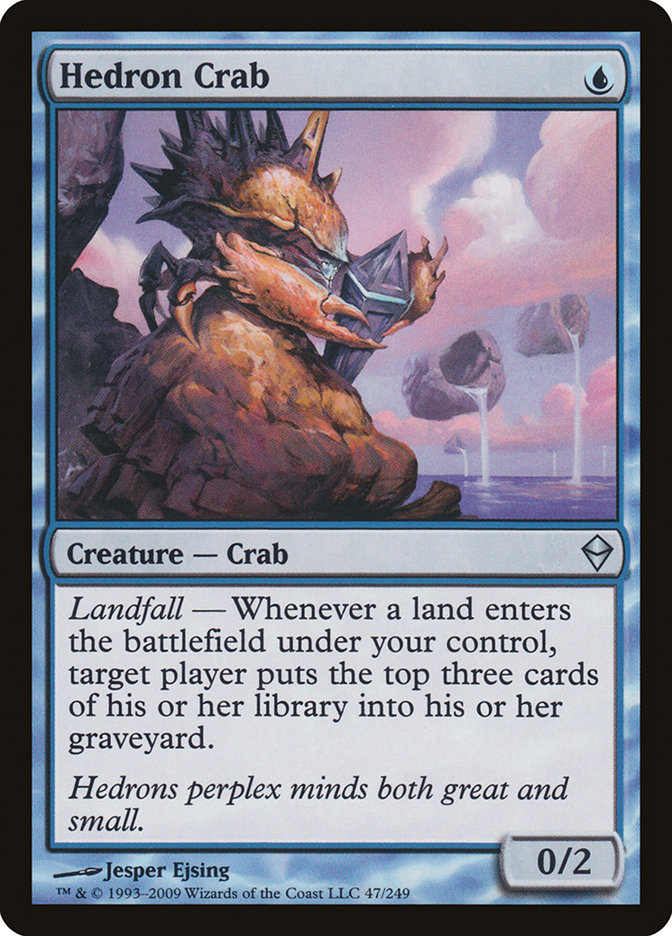I am one of the biggest advocates of playing what you know in Magic and in Modern. Most of the time, the difference between the best few decks is a few percentage points, and Modern has so many archetypes that being familiar with every matchup typically requires years of practice.
But this is the time to throw the usual advice out the window. Sometimes, one deck is so obscenely broken that playing any other archetype is like chump blocking at twenty life: dead wrong. Hogaak put up a 56% win rate at the Mythic Championship, a tournament in which Leyline of the Void was the most-played card.
You may have heard that statistic before, but take a moment here to really consider it. Leading up the tournament, a card was banned from Hogaak, significantly weakening it. Even after that, everyone in the tournament knew Hogaak was good and dedicated huge portions of their sideboard to beating it. In fact, many of them sideboarded four copies of the most hateful card in the entire format.
The metagame breakdown came out, and Hogaak was the most popular deck in the room. It wasn’t just a few elite teams playing it but plenty of grinders and MCQ winners as well. But despite the field being as ready as it could be, despite the banning, despite the finest minds in the game desperately trying to find a solution, Hogaak sported the highest win rate in the entire tournament!
In this article, I will discuss every deck you should consider for your next Modern event. In a shocking turn of events, every single one of these decks contains the card Hogaak, Arisen Necropolis. Let me be very clear: if your sole goal is to win your next Modern event, you should not leave home without everyone’s least favorite zero-mana 8/8. It’s totally reasonable to play with other goals in mind, but please do not play other decks and delude yourself into thinking your choice gave you the best chance to win.
I will begin with one of the most distinctive lists from the Mythic Championship: DredgeGaak.
Creatures (23)
- 3 Golgari Thug
- 4 Stinkweed Imp
- 2 Narcomoeba
- 4 Bloodghast
- 3 Prized Amalgam
- 4 Stitcher's Supplier
- 3 Hogaak, Arisen Necropolis
Lands (19)
Spells (18)

DredgeGaak was a hybrid played by most of Team Legion to an absurd 61% win rate. That number must be taken with a grain of salt, as all of Legion are elite players who would be expected to perform better than the average Mythic Championship competitor. But even given that, I cannot help but be impressed.
This deck played a trimmed-down version of the dredge engine, combined with Stitcher’s Supplier and a fetchable Dryad Arbor to help power out three, but not four, copies of Hogaak, Arisen Necropolis. This deck attempts to marry the strongest aspects of Dredge to the strongest aspects of Hogaak. Specifically, Creeping Chill makes the deck a massive favorite against archetypes like Mono-Red Phoenix and Burn. In those matchups, normal Hogaak is favored but it’s too close for comfort. Conflagrate adds a ton of percentage to the deck’s matchup against any small creature deck, and I expect many players to incorrectly register those decks, primarily Humans. These two cards also give DredgeGaak access to a burn angle of attack, making them substantially better against the Urza, Lord High Artificer decks that posted a noticeably positive matchup against traditional Hogaak at the Mythic Championship.
The weaknesses of DredgeGaak are twofold. First, the deck is far weaker to soft graveyard hate, like Nihil Spellbomb, Relic of Progenitus and Surgical Extraction. With normal Hogaak, a single Stitcher’s Supplier trigger or Faithless Looting will force the opponent to pull the trigger, and rebuilding is generally not too difficult. With Dredge, you’re often mulliganing low on cards to find a Dredger and a discard outlet, so rebuilding after a one-shot effect can require multiple turns of doing nothing.
The more your metagame contains decks with soft hate like Jund, Mono-Green Tron and Izzet Phoenix, the less you should play DredgeGaak. Note that all Hogaak variants are comparably vulnerable to hard graveyard like Rest in Peace and Leyline of the Void, which are rightfully popular now.
The other problem with the deck is that by merging the needs of Hogaak and Dredge, the deck has gotten less efficient at executing both plans. You’ll notice that DredgeGaak has only two Narcomoebas and only three Prized Amalgams, meaning that it will create far fewer free creatures than a traditional Dredge deck. Additionally, keeping a hand with only Shriekhorn to get the dredging started is risky, but not out of the question. But hands with only Stitcher’s Supplier to start the dredging are straight mulligans.
On the Hogaak side of things, this deck has only Stitcher’s Supplier, Golgari Thug and Bloodghast as creatures that can tap for Hogaak the turn they enter the battlefield. This reduces the consistency of the namesake card substantially. Worse, the loss of Vengevine and the fourth Arisen Necropolis hurts the deck’s explosive starts and harms it in the all-too-relevant mirror match.
Overall, I think Humans, Grixis Urza, Burn, and Mono-Red Phoenix are about as popular as Jund, Mono-Green Tron, and Izzet Phoenix. But because the deck is worse in the mirror, it’s hard to justify playing this deck over the traditional one.
The next deck I would like to examine is the Channel Fireball-inspired CrabGaak:
Creatures (31)
- 4 Carrion Feeder
- 4 Bloodghast
- 4 Hedron Crab
- 4 Vengevine
- 4 Gravecrawler
- 3 Satyr Wayfinder
- 4 Stitcher's Supplier
- 4 Hogaak, Arisen Necropolis
Lands (20)
Spells (9)

Since the banning of Bridge from Below, three-color Hogaak lists frequently have a problem where their last few card slots are all lackluster. Whether the specific card is Insolent Neonate, Lightning Axe, or Cryptbreaker, no option is particularly impressive. Hedron Crab, on the other hand, is incredibly explosive and contributes to some of the most broken starts the deck can produce. It also makes this deck the strongest against soft hate since a single Hedron Crab trigger typically trades for their Relic of Progenitus activation. Hedron Crab also has the advantage of being a one-mana creature, which is often critical for Vengevine recursion.
The biggest downside to the CrabGaak lists is the mana. Normal Hogaak decks already needs all of its colors early, resulting in a very painful manabase and some tough fetching decisions when it comes to one-land Faithless Looting hands. Hedron Crab builds push the manabase even further, with the additional pain hurting them in any matchup where their life total is under threat. Also, it makes casting Vengevine in sideboard games nearly impossible. While the deck plays two green sources, realistically you never have enough fetchlands to find both.
This addition of Hedron Crab does make this list favored in the mirror, but only if the traditional lists choose not to spend their flex slots on maindeck Leyline of the Void. At the Mythic Championship, most traditional Hogaak players identified the strength of Leyline and opted to play two or three copies maindeck. But without open decklists, it’s unclear if this strategy can succeed. Knowing whether Leyline is a blank or the stone nuts is crucial to knowing which hands to keep in pre-sideboard games. Additionally, I expect less than 20% of players at the average SCG Open or Grand Prix to play Hogaak, reducing the incentive to be that prepared for the mirror.
The final sub-archetype in consideration is traditional, boring JundGaak:
Creatures (31)
- 4 Carrion Feeder
- 4 Bloodghast
- 4 Vengevine
- 4 Gravecrawler
- 4 Satyr Wayfinder
- 3 Insolent Neonate
- 4 Stitcher's Supplier
- 4 Hogaak, Arisen Necropolis
Lands (19)
Spells (10)

JundGaak is the most consistent of the three decks. Its manabase is smoother than CrabGaak’s and its gameplan is more focused than DredgeGaak’s. The downside of this consistency is that the last several slots in the deck are going to be bad, as I alluded to above. But I don’t think this problem is as large as it may seem at first.
In almost every matchup, Hogaak cuts a significant number of cards to bring in answers to hate. This means that whatever bad cards you choose to include in these slots will not be in your deck for any sideboard games you play at the tournament. On the other hand, CrabGaak will be forced to play their inconsistent manabase for every game, even though Hedron Crab itself is a blank piece of cardboard if a Leyline of the Void or Rest in Peace is on the battlefield.
It’s relevant here that Hogaak has a fairly ludicrous Game 1 win percentage against the format. I think that if your Game 1 draw is functional, you’ll win almost by default. Thus, it doesn’t matter that much if you draw an underpowered card like Insolent Neonate instead of Hedron Crab.
Traditional Hogaak rests between these two extremes in terms of its resiliency to soft graveyard hate and its matchup against Burn and Mono-Red Phoenix. Nihil Spellbomb will be more effective without Hedron Crab, but it also will rarely Time Walk you, and starting at fifteen life is a lot better than starting at eleven life but a lot worse than starting above twenty.
Overall, I think JundGaak is the Goldilocks in this story, not too hot, not too cold but just right. I’m still working to finalize my exact list, but as of now I plan to register this at Grand Prix Minneapolis this weekend:
Creatures (30)
- 4 Carrion Feeder
- 4 Bloodghast
- 4 Vengevine
- 4 Gravecrawler
- 2 Lotleth Troll
- 4 Satyr Wayfinder
- 4 Stitcher's Supplier
- 4 Hogaak, Arisen Necropolis
Lands (20)
Spells (10)

With the understanding that whatever I play in the last few slots will get sideboarded out every round, I currently favor Shriekhorn. It’s a weaker Hedron Crab, but it leads to the most explosive starts. I prefer it to something fundamentally underpowered, even if the underpowered card might remain in my deck occasionally. As I alluded to above, I don’t feel comfortable playing Leyline of the Void maindeck without open decklists, but I’m hoping that the Assassin’s Trophies in the maindeck ensure I have game against anyone who does choose to start it. They also improve my matchup against Mono-Green Tron, which I expect to surge in popularity after winning both recent Modern premier events.
Modern right now is a broken format. I don’t remember the last time a deck survived a banning and still ended up format-warping. But for now, there’s nothing to be done but stop worrying and love the Hogaak.





